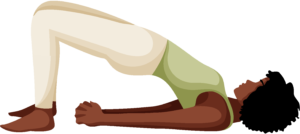Supported Bridge (Setu Bandha Sarvangasana)
Pose Overview
| Common Name | Supported Bridge |
| Traditional Sanskrit Name | Setu Bandha Sarvangasana |
| Sanskrit Name Pronunciation | seh-too bahn-dah sar-vawn-gahs-ah-nah |
| Pose Difficulty | Beginner |
| Drishti
Drishti is the gaze or visual focus point during yoga poses.
Learn more about Drishti |
Upward, towards the sky |
Supported Bridge Pose, or Setu Bandha Sarvangasana in Sanskrit, is a yoga pose that is said to be beneficial for stretching out the chest, shoulders, and neck, as well as for promoting a sense of balance and focus. The name of the pose comes from the fact that it resembles a supported bridge, with the body in an arched position with the legs and arms on the floor and the chest lifted up and supported by a prop such as a block or bolster. The pose is said to be helpful for increasing flexibility and strength in the chest, shoulders, and neck, and for promoting a sense of balance and focus. It is also said to be beneficial for relieving stress and anxiety, and for promoting a sense of inner peace. This pose is also said to help to release tension in the chest, shoulders, and neck, and to help to improve balance and stability.
Benefits of Supported Bridge
Strengthens the core Opens up the chest and shoulders Helps to relieve lower back pain Calms the mind
How to Enter Supported Bridge
Lie on your back with your knees bent and the soles of your feet on the floor. Bring your heels as close to your sitting bones as possible. Press your feet and arms into the floor, lifting your hips up towards the ceiling. Interlace your fingers behind your back and press your shoulders into the floor. Hold for several breaths, then release.
How to Exit Supported Bridge
Release your hands from behind your back and bring your hips down to the floor. Bring your knees to your chest and give yourself a hug to release any tension in your lower back.
Common Supported Bridge Modifications & Variations
To make the pose more restorative, place a block or blanket under your sacrum for support. To make the pose more challenging, try lifting one leg at a time towards the ceiling.
Common Mistakes with Supported Bridge
Arching the lower back too much Not engaging the core Rounding the shoulders
Safety Guidance
If you have a neck injury, avoid this pose or keep your head on the floor and do not interlace your fingers behind your back. If you have a lower back injury, be sure to keep your core engaged and avoid arching your lower back too much.

